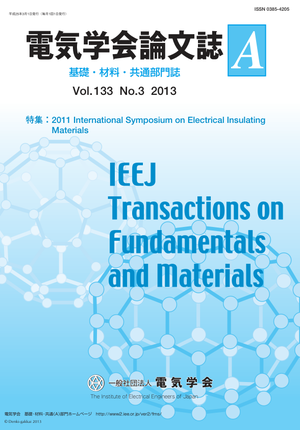Relationship between Remaining Antioxidant Content and Radiation-Thermal Degradation in Crosslinked Polyethylene
Relationship between Remaining Antioxidant Content and Radiation-Thermal Degradation in Crosslinked Polyethylene
カテゴリ: 論文誌(論文単位)
グループ名: 【A】基礎・材料・共通部門
発行日: 2013/03/01
タイトル(英語): Relationship between Remaining Antioxidant Content and Radiation-Thermal Degradation in Crosslinked Polyethylene
著者名: Masaki Kanegami (Electric Power Engineering Research Laboratory, Central Research Institute of Electric Power Industry), Takashi Kurihara (Electric Power Engineering Research Laboratory, Central Research Institute of Electric Power Industry), Norikazu Fus
著者名(英語): Masaki Kanegami (Electric Power Engineering Research Laboratory, Central Research Institute of Electric Power Industry), Takashi Kurihara (Electric Power Engineering Research Laboratory, Central Research Institute of Electric Power Industry), Norikazu Fuse (Electric Power Engineering Research Laboratory, Central Research Institute of Electric Power Industry), Yoshinobu Mizutani (Electric Power Engineering Research Laboratory, Central Research Institute of Electric Power Industry), Hiroya Homma (Electric Power Engineering Research Laboratory, Central Research Institute of Electric Power Industry), Tatsuki Okamoto (Electric Power Engineering Research Laboratory, Central Research Institute of Electric Power Industry)
キーワード: crosslinked polyethylene,cable,elongation at break,oxidation,antioxidant
要約(英語): To clarify the deterioration mechanism of cables installed in nuclear power plants, three kinds of XLPE sheets with differing antioxidant content were aged by 100Gy/h γ-ray irradiation at room temperature, 60℃, and 100℃. The remaining antioxidant content was estimated from the oxidation induction time using differential scanning calorimetry. The elongation at break decreases faster as the initial antioxidant content decreases. On the other hand, the evaluation parameter called oxidation degree, which is defined as the ratio of the absorbance due to carbonyl groups to that due to methylene groups obtained with infrared spectroscopy, increases with aging time. The elongation at break decreases as the oxidation degree increases, and the relationship between these two quantities can be expressed with a sigmoid master curve. Furthermore, both the elongation at break and oxidation degree show reasonably stable transitions until the antioxidant content decreases to a certain value. After this period, the elongation at break changes drastically and reaches a sufficiently low value. The experimental results reveal that there exists a threshold for antioxidant content that is needed to effectively inhibit oxidation.
本誌掲載ページ: 98-104 p
原稿種別: 論文/英語
電子版へのリンク: https://www.jstage.jst.go.jp/article/ieejfms/133/3/133_98/_article/-char/ja/
受取状況を読み込めませんでした


